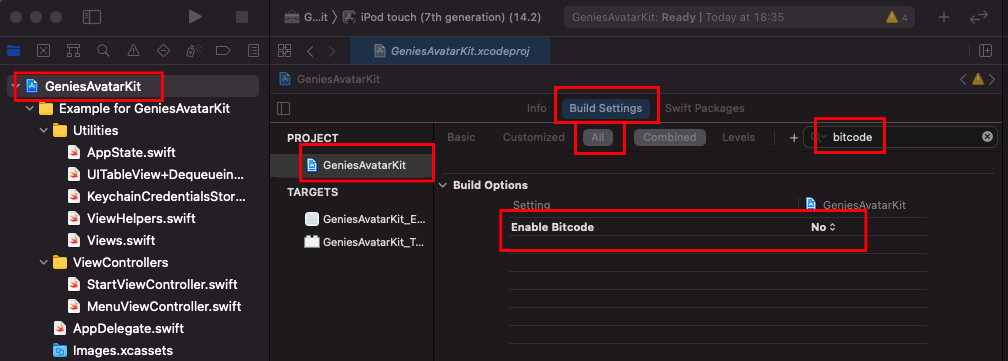iOS#
Avatar Creator#
For integrating the Avatar Creator in your Android App, see the Avatar Creator / iOS section
Authentication & Avatar API wrapper library#
The Authentication API wrapper library provides a convenient way to authenticate with your Partner API Account
The iOS Avatar Authentication library can be found at: https://github.com/geniesinc/GeniesAvatarKit
Installation#
You can install the iOS Authentication library via Cocoapods:
If you just want to use just the API Client:
- Add
pod "GeniesAvatarKit/AvatarAPIClient", git: "https://github.com/geniesinc/GeniesAvatarKit.git"(proper github credentials are required)
If you want to also use the Avatar Creator:
-
Add
pod "GeniesAvatarKit", git: "https://github.com/geniesinc/GeniesAvatarKit.git"(proper github credentials are required) -
Disable Bitcode in XCode project settings - In XCode go to your
project settings>Build Settings> Make sureAllis selected and search forbitcode- Set it toEnabled = No

Usage#
State#
The SDK provides an AvatarAppState object for handling the Genies Avatar API, which will handle the session and API
calls
The AvatarAppState object is the central point of the SDK and requires an initialization with the configuration
objects presented in Configuration.
There should only be one instance of the AvatarAppState running throughout the app's lifecycle. The code samples below
will reference this by AvatarAppState.shared, which should be a singleton instance of AvatarAppState
Configuration#
Configuring the AvatarAppState consists of 3 parts:
- One
AvatarAPIConfigobject, configured with anapi keyand abase URLfor the Genies Avatar API. Example:
AvatarAPIConfig(apiKey: "some-api-key",
baseURL: URL(string: "https://avatar-api-dev.genies.com/dev")!)
- One
AvatarAWSConfigconfigured withclient ID,AWS Region,usernameandpassword. Example:
AvatarAWSConfig(clientID: "some-client-id",
region: .usWest2,
username: "some-username",
password: "some-password")
- One
AvatarCredentialsStoreinstance which should handle storing and getting credentials for communicating with the Genies Avatar API. The example app provides a predefinedKeychainCredentialsStorewhich is used to manage credentials using the underlying iOS Keychain.
If needed You can build your own credentials store by implementing the AvatarCredentialsStore protocol, which requires
two methods:
storeCredentials(_ credentials: AvatarClientCredentials)- should store theIdTokenandrefreshTokenstrings from theAvatarClientCredentialsinstancegetStoredCredentials()- should provide an instance ofAvatarClientCredentialsthat were previously stored, if any exists
These methods are called automatically by the SDK
Signing in with a Partner API Account#
Signing in is done using the AvatarAppState shared instance:
AvatarAppState.shared.signIn { result in
switch result {
case .success:
// Sign in was successful
case .failure(let error):
// There was an error while signing in
print(error.localizedDescription)
}
}
Signing out from the Partner API Account is done by calling:
AvatarAppState.shared.signOut()
This operation will cleanup the internal state of the AvatarAppState instance, and you'll need to sign in again in
order to use the Genies Avatar API.
Getting a user by username#
To get a user's userId use:
AvatarAppState.shared.client.getUser(username: username) { result in
switch result {
case .success(let user):
// Getting the user operation was successful
// In this step you get a User object with userId and username string properties
case .failure(let error):
// There was an error while getting the user
print(error.localizedDescription)
}
}
Getting an user's Avatar Closet#
To get a list of all the assets assigned to a user's closet use:
AvatarAppState.shared.client.getCloset(userId: userId) { result in
switch result {
case .success(let closetItems):
// Getting the closet operation was successful
// In this step you get a list of [ClosetItem] objects
case .failure(let error):
// There was an error while getting the user
print(error.localizedDescription)
}
}
Depositing an asset to a user's closet#
To deposit an asset to a user's closet use:
AvatarAppState.shared.client.deposit(userId: userId, assetId: assetId) { result in
switch result {
case .success(let closetItems):
// Depositing the closet item operation was successful
// In this step you get a list of [ClosetItem] objects
case .failure(let error):
// There was an error while getting the user
print(error.localizedDescription)
}
}
Withdrawing an asset from a user's closet#
To withdraw an asset from a user's closet use:
AvatarAppState.shared.client.withdraw(userId: userId, assetId: assetId, instanceId: instanceId) { result in
switch result {
case .success(_):
// Withdrawing the closet item operation was successful
case .failure(let error):
// There was an error while getting the user
print(error.localizedDescription)
}
}
Creating an anonymous user#
To create a managed anonymous user use:
AvatarAppState.shared.client.createUser(username) { result in
switch result {
case .success(let user):
// Creating the user operation was successful
// In this step you get a User object
case .failure(let error):
// There was an error while creating the user
print(error.localizedDescription)
}
}
Deleting an anonymous user#
To delete a managed anonymous user use:
AvatarAppState.shared.client.deleteUser(username) { result in
switch result {
case .success(_):
// Deleting the user operation was successful
case .failure(let error):
// There was an error while deleting the user
print(error.localizedDescription)
}
}